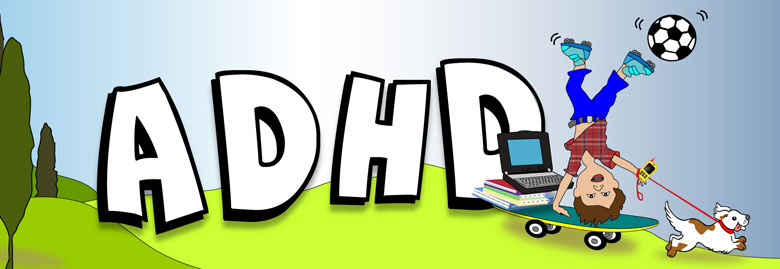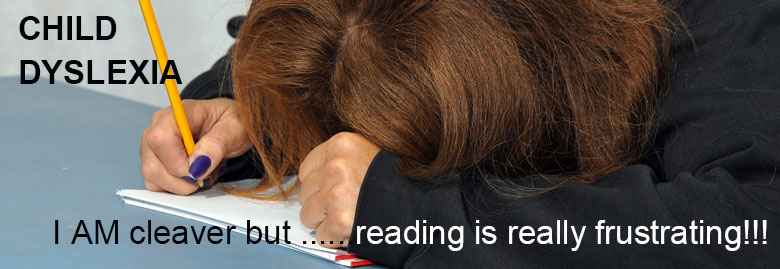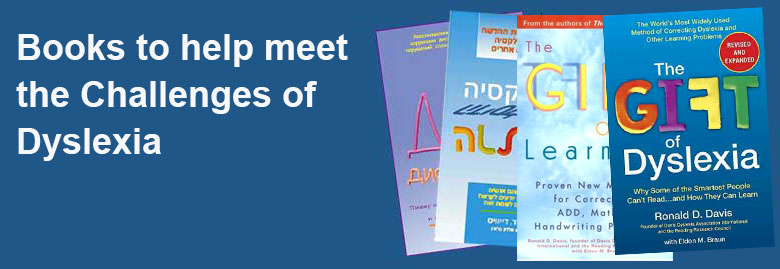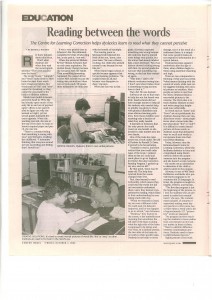Rje horse jumped dmsk mkx fence. That’s what dyslexics see when they read the second-grade sentence “The horse jumped over the fence”.
The words “horse,” “jumped,” and “fence” make sense to their brains because these words have visual equivalents. But words such as “the” and “over” cannot be visualized, so they cannot be processed by the brains of dyslexia sufferers. British-born Judith Schwarcz arrived in Israel in 1976. She had already spent much of her early life in and out of psychologists’ offices as her parents tried to figure out why she seemed so bright, yet her school grades indicated the exact opposite. When the teaching was oral, she was at the top of her class. As soon as lessons required paper and pencil, she was lost.
“There’s a constant feeling that something is wrong with you”, says Schwarcz, recalling her childhood. “I remember thinking that everyone around me was succeeding and feeling that I should too.”
It was a very painful time in Schwarcz’s life. She ultimately completed 12 years of schooling but, as she puts it, “not well.”
The turning point in Schwarcz’s life followed the birth of her son, Yaron, nine years later. “He was a vibrant, exciting, fun child who seemed normal to me because he was like me.”
When Yaron began school, it quickly became apparent that he had learning problems. “He couldn’t learn at all and became very disruptive in class,” she says.
When her son was in first grade, Schwarcz suspected something was wrong because she could see that he learned some things very quickly, but the school had already labeled him a slow developer. Two evaluations showed nothing wrong with him. By second grade she was sure that something was wrong, so she had him evaluated again.
“This time, I said to the didactic evaluators testing him: “’I don’t care what it takes, there is something wrong and you have to find it.’” They did. He was dyslexic.
Schwarcz set out to find ways to help her son but found very little. Israeli schools did not have enough money to help all the students who needed help, so priority was given to those with physical disabilities and more obvious learning problems. Even those children were receiving only a fraction of what they really needed.
It dawned on Schwarcz that the only person she could count on was herself, so she decided to take matters into her own hand.
One of the tools she came across was a book called The Gift of Dyslexia by Ronald. D. Davis. It proved to be her salvation.
“I started to read it, and then noticed that you could order tapes of the book. I ordered them as fast as I could and made plans to go to England for Davis’s five-day Correction Reading Program. I packed up my son, and we left.”
By that point, Yaron was 10 years old. The help they received from the course changed their lives. First, they learned to read technically, which means they could read the words but did not necessarily understand them. Later, they learned comprehensive reading, which filled in their understanding by mastering words with clay.
“When we returned to Israel, my son was a different child. He could read, his behavior improved, and he was happier to go to school,” says Schwarcz. “Dyslexia,” they learned in the course, is the umbrella term meaning that sometimes the left side of the brain is doing what the right side of the brain is supposed to be doing, and vice versa. In a dyslexic person, the two sides of the brain do not stick to their specific tasks. Dyslexia is not brain or nerve damage, nor is it the result of a malformed brain. It is simply that some people’s brains do not respond to information in a typical fashion.
Dyslexia becomes apparent somewhere after the age of three, when children begin to think using analytical reasoning and logic.
There are two components to thinking: verbal and non-verbal. Verbal means thinking with the sounds of words, while non-verbal suggests that thinking with mental pictures or intuition. Most people are better at one than the other. Dyslexics think in non-verbal pictures to the extreme. The Davis idea is to teach dyslexic thinkers to read and write using their heightened non-verbal skills.
So words such as “horse” and “fence” are not problematic for dyslexics because they can visualize those words-most people know what a horse looks like. But what about “the” or “and”? It is difficult to create mental pictures of these words, so dyslexics must find alternative ways to recall such words to incorporate them into their non-verbal thinking.
Today, Schwarcz runs the Ra’anana-based Centre for Learning Correction, where she facilitates dyslexics to focus and comprehend using Davis’s method. Before she accepts someone into her program – and she doesn’t accept everyone – she carries out an assessment to determine if the child or adult is suited to the program.
Schwarcz is one of 406 Davis facilitators worldwide who provide Davis programs in 33 countries and 26 languages. In Israel, the program is taught in English, Hebrew, and Russian. “The five-day program is just the beginning of the process, so l look for students who are prepared to make that commitment,” she says. The commitment includes 15 minutes of supervised reading every day and practice in other areas two or three times a week until a list of approximately 217 “picture-less” words are mastered.
The program involves teaching the students to focus (rather than concentrate) on the subject matter in front of them. “There’s a definite difference between concentration and focus. Dyslexics need to learn to shift between the two.”
Eighty percent of her work involves using molding clay. “When we make the concept of a word in clay, we’re creating that concept in the real world. Take a concept such as ‘in the meantime’ or ‘later’. Students learn to create clay pictures that describe these concepts. Once they have done so, it stays in their minds,” she explains.
Separate programs are designed for those who suffer from attention deficit disorder (ADD); attention deficit hyper-active disorder (ADHD), and learning disabilities (L/D), all of which fall under the umbrella definition of dyslexia.
“Society is very quick to write these people off”, she says, when in fact, many of them are very intelligent. Some end up working in factories when they should be searching for a cure for cancer. Albert Einstein, Leonardo da Vinci, Alexander Graham Bell, Winston Churchill, Walt Disney, and many other gifted thinkers suffered from some form of dyslexia.
Of the 200 students Schwarcz has already facilitated in the Davis Program, her claimed success rate is 97 percent. The other three percent, she says, were simply not motivated.
Israeli schools, with an average class size of 40, are not well suited to identifying children with learning issues. If a first grader is not succeeding, it is the parents’ obligation to ask for an evaluation and make sure the child gets it, says Schwarcz.
Teachers of younger students often suggest that families wait and see what happens for a while, but Schwarcz disagrees. “Parents must trust their own instincts and lead the effort to get these children the help they need,” she asserts.
Classes for students with learning issues are available in Israel, but not enough exist. There are not enough resources to properly help these youngsters, who often end up grouped together with other children with behavioral issues. Many turn to crime and other destructive activities.
“No education means no matriculation and, in turn, no options. Israel should focus less on funding juvenile centers and more on education,” says Schwarcz.
MENTAL IMAGES. Dyslexics think in non-verbal pictures. CREATIVE SOLUTIONS. It’s hard to create mental pictures of words like ‘the’ or ‘and,’ so other methods are used to fix them in the mind’s eye. Click to listen highlighted text! Reading between the words The Centre for Learning Correction helps dyslexics learn to read what they cannot perceive By KENDALL WIGODA Rje horse jumped dmsk mkx fence. That’s what dyslexics see when they read the second-grade sentence “The horse jumped over the fence”. The words “horse,” “jumped,” and “fence” make sense to their brains because these words have visual equivalents. But words such as “the” and “over” cannot be visualized, so they cannot be processed by the brains of dyslexia sufferers. British-born Judith Schwarcz arrived in Israel in 1976. She had already spent much of her early life in and out of psychologists’ offices as her parents tried to figure out why she seemed so bright, yet her school grades indicated the exact opposite. When the teaching was oral, she was at the top of her class. As soon as lessons required paper and pencil, she was lost. “There’s a constant feeling that something is wrong with you”, says Schwarcz, recalling her childhood. “I remember thinking that everyone around me was succeeding and feeling that I should too.” It was a very painful time in Schwarcz’s life. She ultimately completed 12 years of schooling but, as she puts it, “not well.” The turning point in Schwarcz’s life followed the birth of her son, Yaron, nine years later. “He was a vibrant, exciting, fun child who seemed normal to me because he was like me.” When Yaron began school, it quickly became apparent that he had learning problems. “He couldn’t learn at all and became very disruptive in class,” she says. When her son was in first grade, Schwarcz suspected something was wrong because she could see that he learned some things very quickly, but the school had already labeled him a slow developer. Two evaluations showed nothing wrong with him. By second grade she was sure that something was wrong, so she had him evaluated again. “This time, I said to the didactic evaluators testing him: “’I don’t care what it takes, there is something wrong and you have to find it.’” They did. He was dyslexic. Schwarcz set out to find ways to help her son but found very little. Israeli schools did not have enough money to help all the students who needed help, so priority was given to those with physical disabilities and more obvious learning problems. Even those children were receiving only a fraction of what they really needed. It dawned on Schwarcz that the only person she could count on was herself, so she decided to take matters into her own hand. One of the tools she came across was a book called The Gift of Dyslexia by Ronald. D. Davis. It proved to be her salvation. “I started to read it, and then noticed that you could order tapes of the book. I ordered them as fast as I could and made plans to go to England for Davis’s five-day Correction Reading Program. I packed up my son, and we left.” By that point, Yaron was 10 years old. The help they received from the course changed their lives. First, they learned to read technically, which means they could read the words but did not necessarily understand them. Later, they learned comprehensive reading, which filled in their understanding by mastering words with clay. “When we returned to Israel, my son was a different child. He could read, his behavior improved, and he was happier to go to school,” says Schwarcz. “Dyslexia,” they learned in the course, is the umbrella term meaning that sometimes the left side of the brain is doing what the right side of the brain is supposed to be doing, and vice versa. In a dyslexic person, the two sides of the brain do not stick to their specific tasks. Dyslexia is not brain or nerve damage, nor is it the result of a malformed brain. It is simply that some people’s brains do not respond to information in a typical fashion. Dyslexia becomes apparent somewhere after the age of three, when children begin to think using analytical reasoning and logic. There are two components to thinking: verbal and non-verbal. Verbal means thinking with the sounds of words, while non-verbal suggests that thinking with mental pictures or intuition. Most people are better at one than the other. Dyslexics think in non-verbal pictures to the extreme. The Davis idea is to teach dyslexic thinkers to read and write using their heightened non-verbal skills. So words such as “horse” and “fence” are not problematic for dyslexics because they can visualize those words-most people know what a horse looks like. But what about “the” or “and”? It is difficult to create mental pictures of these words, so dyslexics must find alternative ways to recall such words to incorporate them into their non-verbal thinking. Today, Schwarcz runs the Ra’anana-based Centre for Learning Correction, where she facilitates dyslexics to focus and comprehend using Davis’s method. Before she accepts someone into her program – and she doesn’t accept everyone – she carries out an assessment to determine if the child or adult is suited to the program. Schwarcz is one of 406 Davis facilitators worldwide who provide Davis programs in 33 countries and 26 languages. In Israel, the program is taught in English, Hebrew, and Russian. “The five-day program is just the beginning of the process, so l look for students who are prepared to make that commitment,” she says. The commitment includes 15 minutes of supervised reading every day and practice in other areas two or three times a week until a list of approximately 217 “picture-less” words are mastered. The program involves teaching the students to focus (rather than concentrate) on the subject matter in front of them. “There’s a definite difference between concentration and focus. Dyslexics need to learn to shift between the two.” Eighty percent of her work involves using molding clay. “When we make the concept of a word in clay, we’re creating that concept in the real world. Take a concept such as ‘in the meantime’ or ‘later’. Students learn to create clay pictures that describe these concepts. Once they have done so, it stays in their minds,” she explains. Separate programs are designed for those who suffer from attention deficit disorder (ADD); attention deficit hyper-active disorder (ADHD), and learning disabilities (L/D), all of which fall under the umbrella definition of dyslexia. “Society is very quick to write these people off”, she says, when in fact, many of them are very intelligent. Some end up working in factories when they should be searching for a cure for cancer. Albert Einstein, Leonardo da Vinci, Alexander Graham Bell, Winston Churchill, Walt Disney, and many other gifted thinkers suffered from some form of dyslexia. Of the 200 students Schwarcz has already facilitated in the Davis Program, her claimed success rate is 97 percent. The other three percent, she says, were simply not motivated. Israeli schools, with an average class size of 40, are not well suited to identifying children with learning issues. If a first grader is not succeeding, it is the parents’ obligation to ask for an evaluation and make sure the child gets it, says Schwarcz. Teachers of younger students often suggest that families wait and see what happens for a while, but Schwarcz disagrees. “Parents must trust their own instincts and lead the effort to get these children the help they need,” she asserts. Classes for students with learning issues are available in Israel, but not enough exist. There are not enough resources to properly help these youngsters, who often end up grouped together with other children with behavioral issues. Many turn to crime and other destructive activities. “No education means no matriculation and, in turn, no options. Israel should focus less on funding juvenile centers and more on education,” says Schwarcz. MENTAL IMAGES. Dyslexics think in non-verbal pictures. CREATIVE SOLUTIONS. It’s hard to create mental pictures of words like ‘the’ or ‘and,’ so other methods are used to fix them in the mind’s eye. Powered By GSpeech








